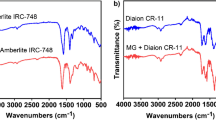Abstract
Solutions of white consumption and khandsari sugar, jaggery and molasses were passed through cation-exchange resins, to eliminate the possibility of reduction of cationic substances during polarographic analysis. The solution thus obtained showed well-defined polarograms. The half-wave potential of all such technical sugar solutions was found to be ≃ 1·5 volt. The straight lines obtained between diffusion current and concentration showed the possibility of quantitative estimation of the substance reduced, which appeared to be some anionic surface active compound present in the systems. The irreversible nature of reductions of the sufrace active compounds was established. The importance of the reduction with similar half-wave potential in establishing the role of anionic substances in many sugar technological problems are expected to be established by this approach. The white consumption sugars were characterised by absence of any polarographic wave. The concentration of the reducible substance was found more in molasses than in jaggery and still less in khandsari.
Similar content being viewed by others
References
Spencer, G. L. and Meade, G. P.Cane Sugar, Hand Book, New York, 1948, p. 355.
Gupta, S. C. and Agarwal S. K. D.Sugar News, 1970, pp. 32–45.
Casey’s John, A. ..PHIL-SUTECH Convention, 1965.
Demetrio, I., Balagao and Navarro ReynaldoSugar News, 1967, pp. 28–31.
Gupta, S. C., Ramaiah N. A. and Bansal J. P.Proc. 34th Ann. Conv. S.T.A. (India), 1966, Part II, pp. 231–33.
Brokaw, C. .. Personal Communication, U.S.A. 1969.
-----Proc. 14th Session ICUMSA, 1966, p. 114.
Hibbert, D.et al. ..Tech. Papers 20th Ann. Meeting, Sugar Industry Technicians, Inc., 1961, pp. 105–112.
Schiweck, H...Zucker, 1963,16, 80–88.
Moroz, R. D. and Yankelevits, Y.Proc. 1964Tech. Session on Cane Sugar Refining Res., U.S.D.A., Agr. Res. Service, 1965,2, 10.
Ramaiah, N. A. and Trivedi, S. R.Sharkara, 1969,11 (4), 120–24.
Gupta, S. L. and Agarwal, S. K. D.Kolloid-Z, 1959,163, 136–38.
Ramaiah, N. A. and Agarwal, S. K. D.Proc. Ind. Acad. Sci., 1956,44 (1), 26–35.
Agarwal, S. K. D...Proc. S.I.J., U.S.A., 1966,25, 60–74.
—————..Int. Sug. Jour., 1966,68, 231–35.
Author information
Authors and Affiliations
Additional information
Communicated by Prof. S. N. Gundu Rao,f.a.sc.
Rights and permissions
About this article
Cite this article
Agarwal, S.K.D., Gupta, R.K. A new polarographic method for estimation of anionic surface active compounds in technical sugar solutions using cation-exchange resin. Proc. Indian Acad. Sci. 80, 35–49 (1974). https://doi.org/10.1007/BF03046671
Received:
Issue Date:
DOI: https://doi.org/10.1007/BF03046671




